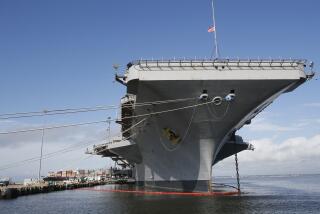Navy Hospital’s 15-Story Tower Bears F.D.R. Imprint : Bethesda Hit by Surgery Scandal, Cited for Deficiencies
- Share via
WASHINGTON — Since the day more than 45 years ago when President Franklin D. Roosevelt personally sketched for Navy architects his vision for an imposing 15-story tower, Bethesda Naval Medical Center in suburban Bethesda, Md., has become synonymous with presidential health.
But the hospital where President Reagan on Saturday underwent surgery for removal of a large growth in his intestine has been rocked in recent months by medical scandal. Its chief heart surgeon, who was dismissed for incompetence in April, was formally charged by the Navy last month with killing four patients by bungling their coronary artery bypass surgery.
Although the hospital is considered the Navy’s medical flagship, it was cited for serious deficiencies in 1982 inspections. Even today, some independent medical authorities rank the facility as “about average.”
Retained Confidence
Yet it clearly has retained the confidence of the White House in recent years. President Lyndon B. Johnson had his gallbladder removed there in 1965, and every President since then has used it for at least minor treatment or checkups.
“In something like the President’s case, I’m sure the care will be excellent,” one prominent Washington surgeon said Saturday, “but for the average patient, the general standard of care may not be equal to other medical schools.”
The surgeon, who asked to remain anonymous, added: “I think it (Bethesda) would rank about in the middle of American medical schools. It certainly wouldn’t rank at the top. Some departments have pretty poor records.”
He cited the case of Dr. Donal M. Billig, fired as chief of cardiothoracic surgery in the midst of an investigation that resulted in a formal Navy charge June 27 that he did “by culpable negligence unlawfully kill” four patients through the use of improper surgical techniques.
In 1982, the hospital was jolted by twin embarrassments when the Joint Commission on Accreditation of Hospitals and the Navy inspector general’s office found serious deficiencies. Hospital officials said the flaws did not reflect on the quality of care but instead centered on a failure to document that quality. Reorganization and reassignments followed, and in 1983 the hospital’s accreditation was renewed for three years.
The hospital’s main tower was completed in late 1941, and its design carried Roosevelt’s personal imprint. According to historians, Roosevelt rejected the original design for a conventional five-story hospital building, giving architects instead his own sketch for the 15-story white tower that dominates the campus-like setting where other naval medical facilities have also been constructed.






